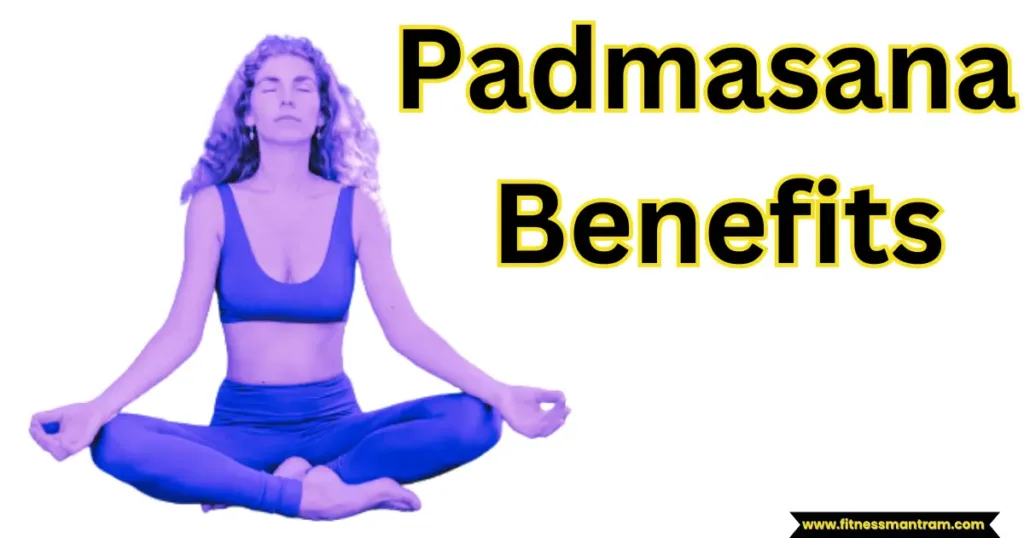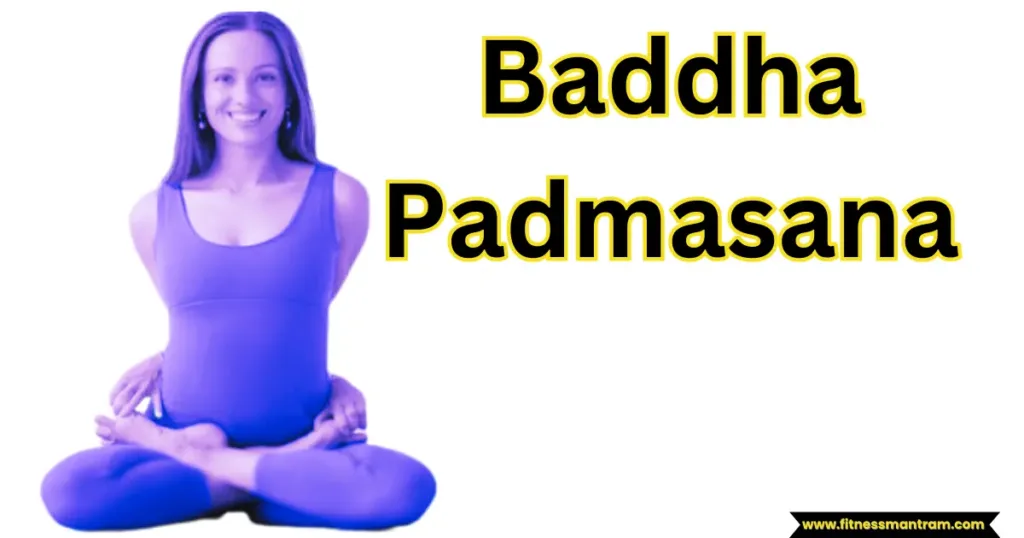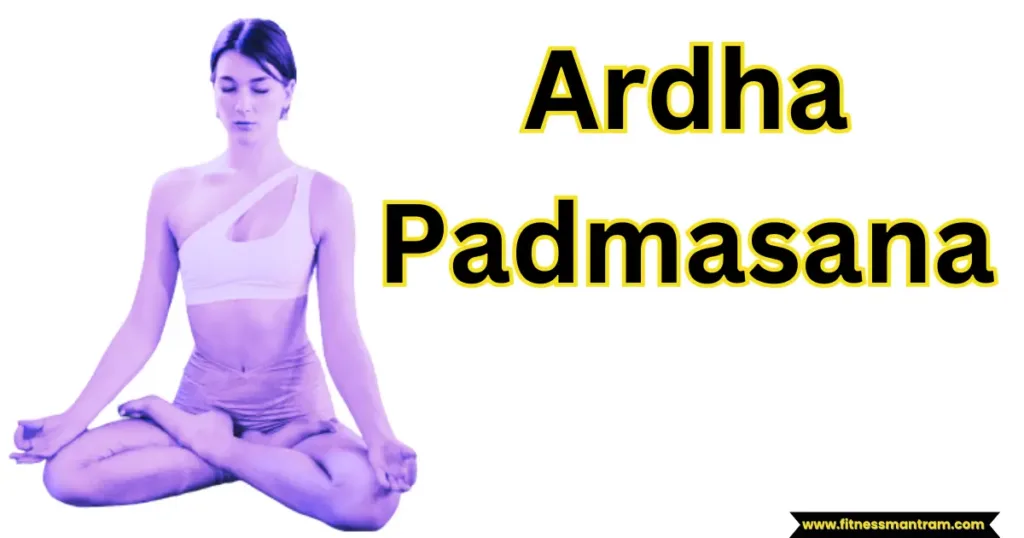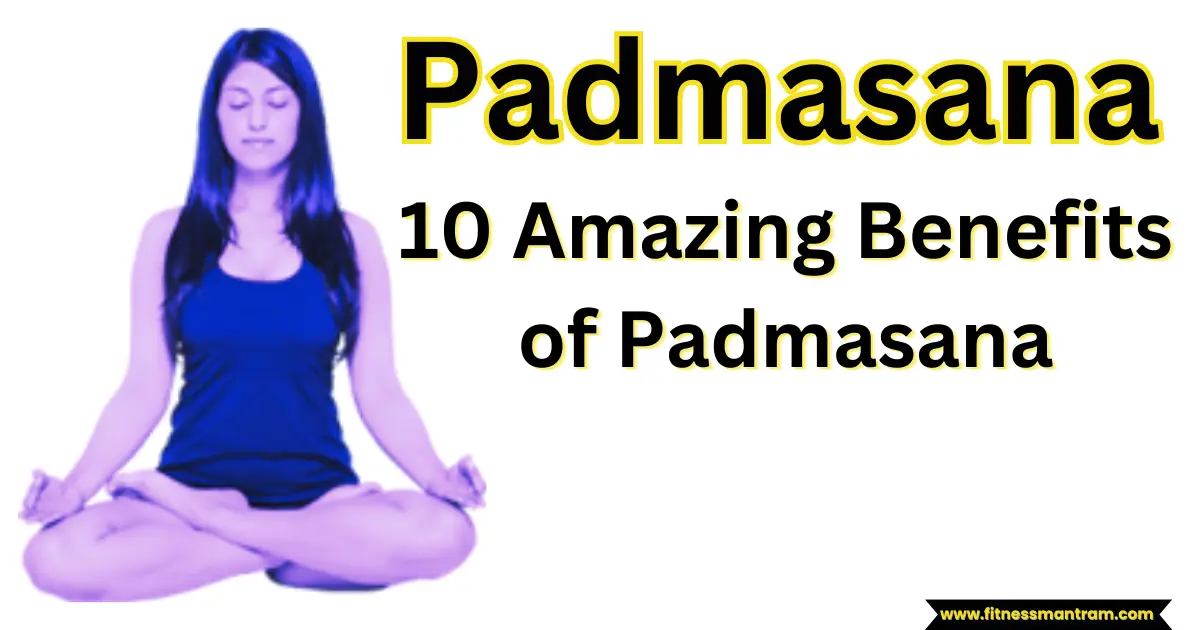Discover the serene and balancing effects of Padmasana, the Lotus Pose. Learn about its physical and mental benefits, proper technique, modifications, and its connection to meditation. Find inner harmony and peace through this ancient yoga posture.
Padmasana: The Lotus Pose for Mind and Body Harmony
In the fast-paced modern world, finding moments of calm and inner peace has become increasingly essential. Yoga, an ancient practice originating from India, offers a wide array of techniques to achieve this harmony. One such pose that embodies serenity and balance is Padmasana, commonly known as the Lotus Pose.
What is Padmasana?
It is a seated yoga posture that resembles a lotus flower. The Padmasana word is originated from the Sanskrit language in which “Padma” means lotus and “Asana” means Pose. It is characterized by crossing the legs and placing the feet on the opposite thighs while maintaining an upright spine.
Padmasana Yoga
This asana, also known as Lotus Pose, is a seated yoga posture that is commonly practiced for meditation and breathing exercises. Follow the instructions as given below how to perform this asana
- Sit on the floor or a yoga mat and keep your leg extended in front of you
- Bend your right knee and bring your right foot toward your left hip crease.
- Similarly, bend your left knee and bring your left foot toward your right hip crease.
- Keep the soles of your foot pointing upward facing towards the ceiling, and allow your knees to drop gently towards the ground.
- Make sure your spine is straight and aligned. If required you can even adjust the position of your feet and legs to get in to a comfortable and stable posture.
- Rest your hands on your knees or place them in a mudra (a hand gesture commonly used in yoga) such as the Jnana Mudra (thumb and index finger touching, other fingers extended).
- Slowly close your eyes and try to relax your body, by focusing on your breath.
- Maintain the posture for a few minutes or for the duration of your meditation or breathing practice.
Note: This asana requires flexibility in the hips and knees. If you find it difficult to perform the full posture, you can modify it by practicing Half Lotus Pose (Ardha Padmasana) or Easy Pose (Sukhasana) until you develop the necessary flexibility. Keep in mind don’t push your body hard while practicing, if you feel any pain or discomfort stop practicing and consult with a certified yoga teacher.
Origin and Significance of Padmasana
This asana holds a deep-rooted significance in the practice of yoga and meditation. It is there mentioned in the Patanjali Yoga Sutras and also in the ancient text like Hatha Yoga Pradipika .The lotus, often associated with purity and enlightenment in various cultures, symbolizes the unfolding of the spiritual journey.
Padmasana Benefits
This asana offers several benefits for both the body and the mind. Here are some of the potential benefits of practicing Lotus Pose.

- Stability and grounding: This asana help in establishing a stable and grounded seated posture. By balancing the body on the sit bones and engaging the core muscles, it promotes a sense of stability and stillness.
- Improved posture: Regular practice of this asana can help improve posture by strengthening the back and the core muscles. It encourages an upright alignment of the spine, reducing the risk of slouching or developing poor posture habits.
- Increased flexibility: It requires flexibility in the hips, knees, and ankles. Consistent practice can gradually improve the range of motion in these joints, leading to increased flexibility and ease of movement.
- Stimulates energy centers: In yoga, this asana is believed to activate the energy centers in the body, particularly the Muladhara (root) and Svadhisthana (sacral) chakras. This can help balance and channelize the flow of energy throughout the body.
- Calms the mind: This asana is often used for meditation and breath-focused practices. The pose promotes a sense of calmness, relaxation, and mental clarity. It also promotes the inner peace and help us to reduce anxiety and stress.
- Enhances focus and concentration: The stillness and stability cultivated in this asana support improved focus and concentration. It allows the practitioner to redirect their attention inward, promoting mindfulness and a deeper connection with the present moment.
- Stimulates digestion and circulation: The position of the legs and the activation of the core muscles in this asana can aid in improving digestion and stimulating the abdominal organs. It also facilitates healthy blood circulation throughout the body.
- Balances energy flow: This asana is considered a balancing posture in yoga, helping to balance the flow of prana (vital energy) in the body. This balance can promote overall well-being and harmony.
- Physical Benefits of Practicing Padmasana: Apart from its symbolic meaning, this asana offers numerous physical benefits. It helps in strengthening the spine, helps us to improve our body posture and also to increase flexibility in hips and knees. It stimulates the abdominal organs, enhances digestion, and can relieve menstrual discomfort. Regular practice of this asana also promotes blood circulation in the lower body.
- Mental and Spiritual Benefits of Padmasana: Beyond the physical realm, this asana nurtures the mind and spirit. By assuming a stable and balanced posture, practitioners experience a sense of groundedness and tranquility. It helps us to improve our concentration by calming our mind and reducing the anxiety. Padmasana is often used as a preparation for meditation, as it facilitates an upright spine and supports deep breathing.
Remember, it’s essential to practice Padmasana with caution and respect for your body’s limitations. When you are planning to practice this asana, it is necessary to take prior advice from a certified medical expert or yoga instructor, if you have any earlier medical issues or injuries.
Padmasana Steps
To practice this asana correctly, follow these steps as given below
- Step 1: Select a quiet and comfortable place to sit.
- Step 2: Extend your legs in front of you and gently bend the right knee.
- Step 3: Place the right foot on the left thigh, ensuring the sole faces upward.
- Step 4: By placing the left foot on to the right thigh you can repeat the same process with the left leg,
- Step 5: Rest your hands on the knees or place them in a mudra (hand gesture) of your choice.
- Step 6: Relax your shoulders, engage your core, and lengthen your spine
- Step 7: By keeping focus on your breath, slowly lose your eyes, and achieve the state of calm.
Baddha Padmasana
Baddha Padmasana, also known as Bound Lotus Pose, is a seated yoga posture that involves sitting in the lotus position with the hands bound behind the back. Here’s a step-by-step guide to practicing Baddha Padmasana

- Start by sitting on the floor in a comfortable cross-legged position, such as Sukhasana (Easy Pose), with your spine erect and shoulders relaxed.
- Slowly bring your right foot onto your left thigh, placing it as close to your hip crease as possible. Ensure that the sole of your foot is facing upward and your knee is pointing downward.
- Similarly, bring your left foot onto your right thigh, crossing your legs in a lotus position. Do the same again by keeping the sole of your foot pointing upward and your knee facing downward.
- Now, reach your right hand behind your back and your left hand over your left shoulder, trying to clasp your hands together. You can also use a strap or a towel to fill the gap between both hands, If you are not able to meet them.
- As you hold the bound position, focus on maintaining an upright posture and a steady breath. Allow your body to settle in the position by relaxing your facial muscles.
- Stay in Baddha Padmasana for a few breaths or as long as feels comfortable. You can gradually increase the duration over time with regular practice.
- To release the pose, slowly release the bind of your hands and gently unfold your legs, returning to a comfortable seated position.
It’s important to approach this pose with patience and respect for your body’s limitations. If you experience any pain or discomfort, you can modify the pose by practicing Ardha Padmasana (Half Lotus Pose) instead, where one foot is placed on the opposite thigh while the other foot remains on the floor. Remember to listen to your body and stop if anything feels excessive or painful.
Ardha Padmasana
Ardha Padmasana, also known as Half Lotus Pose, is a seated yoga posture that involves sitting with one foot resting on the opposite thigh while the other leg remains relaxed. Here’s a step-by-step guide to practicing Ardha Padmasana

- Start by sitting on the floor in a comfortable cross-legged position, such as Sukhasana (Easy Pose), with your spine erect and shoulders relaxed.
- Slowly bring your right foot onto your left thigh, placing it as close to your hip crease as possible. Ensure that the sole of your foot is facing upward and your knee is pointing downward.
- If you find it challenging to bring your foot onto the opposite thigh comfortably, you can modify the pose by placing your right foot on your left calf instead. This modification allows you to experience a similar stretch without straining your knee or hip.
- As you settle into the pose, make sure your spine remains erect, and your pelvis is neutral. You can gently rock your hips side to side to find a comfortable position.
- Now, relax your right leg and foot, allowing them to rest naturally on the floor or mat. You can also place a blanket or bolster under your right knee or ankle for additional support.
- Keep your left leg crossed in front, either in a simple cross-legged position or in a half lotus position by placing your left foot onto your right thigh with the sole facing upward.
- Maintain a straight spine, relax your shoulders, and find a position for your hands that feels comfortable. You can rest your hands on your knees, place them in a mudra, or adopt any other hand position that suits you.
- Take deep, steady breaths, and allow your body to relax into the pose. Stay in Ardha Padmasana for a few breaths or as long as feels comfortable.
- To release the pose, gently unfold your legs, returning to a comfortable seated position.
Remember to practice with awareness and respect for your body’s limitations. If you experience any pain or discomfort, adjust the pose or choose a more suitable variation. It’s always essential to listen to your body and modify the practice accordingly.
Precautions and Modifications for Padmasana
While Padmasana offers many benefits, it is important to practice it mindfully and with respect for your body’s limitations. If you experience knee or hip discomfort, you can modify the pose by sitting on a cushion or folded blanket. Avoid forcing your legs into the lotus position if it causes pain or strain. Gradually work on opening the hips through preparatory exercises.
Padmasana: Variations and Advanced Poses
Padmasana provides a foundation for various advanced poses and variations. One such variation is Ardha Padmasana or Half Lotus Pose, where only one foot is placed on the opposite thigh while keeping the other leg extended. This modification can be beneficial for those with limited flexibility or knee issues.
Another variation is Eka Pada Padmasana or One-Legged Lotus Pose. In this pose, one leg is placed in the lotus position while the other leg remains extended, creating a deeper stretch in the hips and groin area. It requires balance and focus, making it an intermediate level pose.
For practitioners seeking more challenge, the Full Lotus Pose, known as Purna Padmasana, can be explored. Both legs are placed in the lotus position, creating a powerful sense of stability and alignment. It is essential to approach the full lotus pose gradually and with caution, as it requires significant hip and knee flexibility.
Padmasana and Meditation
This asana is widely recognized as a preparatory pose for meditation. The seated posture with an elongated spine promotes an alert yet relaxed state of mind, allowing practitioners to delve deeper into their meditation practice. The stability and symmetry of Padmasana create a harmonious environment for cultivating mindfulness and inner awareness.
When combined with rhythmic breathing techniques, such as alternate nostril breathing or ujjayi pranayama, Padmasana becomes a gateway to a profound meditative experience. In this lotus positions the flow of energy is balanced within the body that result to increase in mental clarity and spiritual connection.
Padmasana in The Modern World
In today’s fast-paced society, where stress and anxiety are prevalent, Padmasana offers a sanctuary of calm. It serves as a reminder to slow down, reconnect with oneself, and find inner balance amid the chaos. Many individuals incorporate Padmasana into their daily routine to counteract the effects of sedentary lifestyles and digital overload.
Moreover, this asana has gained popularity beyond yoga studios and meditation retreats. It has found its place in various wellness practices, including mindfulness workshops, stress management programs, and corporate wellness initiatives. Due to its simplicity and easy to perform this asana is most commonly used by individuals from all walks of life.
Conclusion
Padmasana, the Lotus Pose, serves as a gateway to inner harmony and balance. It is a valuable part of any yoga or meditation practice due to its spiritual, mental, and physical advantages. Doing Padmasana on regular basis you will be able to calm your mind, increase your body flexibility, and will also be able to improve your body posture and overall well being
In the hustle and bustle of modern life, taking a few moments to assume the Lotus Pose can be transformative. It helps you to disconnect from external distraction which helps you to cultivate a sense of stillness and tranquillity. The regular practice of Padmasana will take you on a calm and pleasant journey of self-discovery and inner peace.
Frequently Asked Questions
Q1: Can anyone practice Padmasana?
A1: While Padmasana is accessible to most individuals, those with knee or hip injuries or limitations may need to modify the pose or choose alternative seated postures. Don’t Push your body hard to perform this asana practice with in your body limits.
Q2: How long should I hold Padmasana?
A2: You can start with holding Padmasana for a few minutes and gradually increase the duration as your comfort and flexibility improve. While performing this asana It is essential to keep your focus on the body posture and breath rather than the time period.
Q3: Can Padmasana help with back pain?
A3: Padmasana can help improve posture and strengthen the muscles supporting the spine, which may provide relief from mild back pain. If you have any medical problem or chronic disease, before you start to practice this asana, you should consult and take personal advice from a certified medical professional
Q4: Can pregnant women practice Padmasana?
A4: Pregnant women should exercise caution when practicing Padmasana, especially during the later stages of pregnancy. It is recommended to consult a prenatal yoga instructor or healthcare provider for suitable modifications or alternative poses.
Q5: Can Padmasana be practiced on a chair?
A5: Yes, Padmasana can be modified to a seated cross-legged position on a chair. This variation can be beneficial for individuals with limited flexibility or difficulty sitting on the floor.
You may Also Like
- Dhanurasana: Unleashing the Power of the Bow Pose
- Gomukhasana: Discover the Healing Power of Gomukhasana
- Swastikasana: Discover the Hidden Benefits of Swastikasana
- 28-Day Wall Pilates Challenge – Elevate Your Fitness Journey
- How a Balanced Diet Chart Can Transform Your Life?
Disclaimer : The details & information given here in this article is based on information as available on other published site on internet. Do take medical advice before adopting it. Fitness Mantram Does Not Confirm It. This site contains affiliate links. If you choose to make a purchase after clicking a link the author/owner/creator may receive a commission at no ADDITIONAL cost to you. Thank you for your support!

2 thoughts on “Padmasana-10 Amazing Benefits of Padmasana”